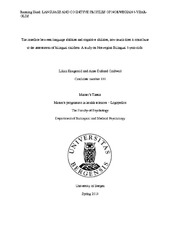The interface between language abilities and cognitive abilities, how much does it contribute to the assessment of bilingual children. A study on Norwegian Bilingual 8-year-olds
Master thesis
Permanent lenke
https://hdl.handle.net/1956/17894Utgivelsesdato
2018-06-13Metadata
Vis full innførselSamlinger
Sammendrag
The main aim of this study was to separate transient between language problems from problems caused by SLI and/or dyslexia among bilingual 8-year olds having Norwegian as their second language (L2). The sample in the study was 20 bilingual-3rd grade school children from a larger Norwegian city. We had a control group of 42 monolingual children, from a previous study. Assessment tools were based on both linguistic (L2) skills and neurocognitive factors, according to the three levels (symptomatic, cognitive and biological) of the differential diagnosis model by Morton and Frith. We hypothesized that bilingual children with language impairment can be identified by Morton and Frith’s differential diagnostic model. We thus aimed to explore whether the differential diagnosing model, can serve as a method in defining language impairment in bilingual children. We also wished to see if bilingual participants exhibit some cognitive advantages over their monolingual counterparts. We hypothesized that monolinguals will outperform bilinguals on language abilities, but no group differences were expected with respect to neurocognitive abilities. As predicted our findings showed poor bilingual performances in language tests compared to monolingual performances. The neurocognitive tests showed bilingual strengths in visual and auditory processing compared to the L1 group. Findings from our study clinically imply that the differential diagnostic model can be used to identify bilingual children at risk of having language impairment and/ or dyslexia, from children with between language problems. Hovedformålet med denne studien var å kunne skille mellom språkvansker som skyldes en forbigående mellomspråklig vanske, og vansker som skyldes SLI og /eller dysleksi hos tospråklige 8 -åringer med Norsk som andrespråk. Utvalget i studien var 20 tospråklige 3.-klassinger fra en større norsk by. Vi hadde en kontrollgruppe på 42 enspråklige barn, fra en tidligere studie. Testbatteriet var basert på både språklige (L2) ferdigheter og nevrokognitive faktorer, i henhold til de tre nivåene (symptomatisk, kognitivt og biologisk) hentet fra den differensialdiagnostiske modellen til Morton og Frith. Vår hypotese var at tospråklige barn med språkvansker kan identifiseres av Morton og Frith sin modell for differensialdiagnostisering. Vi ønsket også å se om tospråklige barn har noen nevrokognitive fordeler i forhold til den enspråklige gruppen. Vår hypotese var at enspråklige vil ha bedre resultat på de språklige testene i forhold til L2-gruppen, men det var ikke forventet noen forskjeller på gruppene med hensyn til nevrokognitive evner. Som ventet, viste funnene dårligere resultat på språktestene for L2 -gruppen i forhold til den enspråklige gruppen. De kognitive testene viste at de tospråklige hadde bedre resultat på de testene som omhandlet visuelle og auditive evner sammenlignet med L1-gruppen. Resultatene fra studien viser at det er mulig å bruke den differensialdiagnostiske modellen til å identifisere tospråklige barn som er i risikosone for å ha språkvansker og/eller dysleksi og å skille mellom dem og de som har en mellomspråklig vanske.
